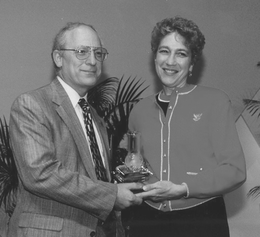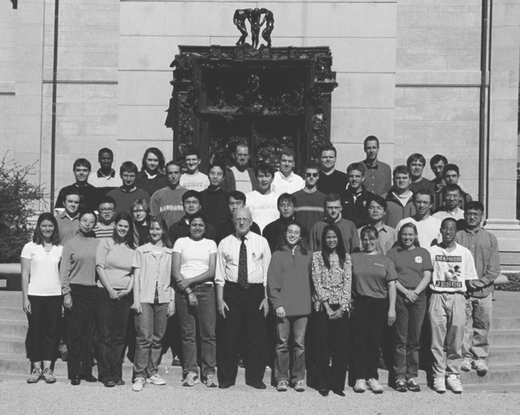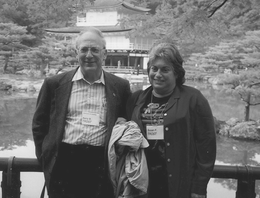Barry M. Trost
A profile of Barry Trost, outlining his career and contribution to green chemistryBarry M. Trost was born in Philadelphia, Pennsylvania, USA on June 13, 1941. As this was the adopted home of Benjamin Franklin, he was exposed to science at an early age and was strongly attracted by the excitement of discovery that it offered. Coming from a middle class immigrant family, he was the first of his family to go to a university. He went through the Philadelphia public schools and was awarded a full tuition scholarship to attend the University of Pennsylvania, graduating cum Laude in 1962. The beauty and intellectual challenges of organic chemistry exemplified by the extraordinary teaching of Allan Day and Madeline Jouillié there revealed this field as his calling. During this time, he performed independent study in the laboratory of a new Assistant Professor, Edward Thornton. Thornton, coming from MIT, persuaded him to pursue his graduate studies at MIT which he completed in less than three years. The topic of his dissertation under the direction of Herbert O. House was the structure and reactivity of enolates.
Upon graduating from MIT in 1965, he joined the University of Wisconsin-Madison as an Assistant Professor and was rapidly promoted to Associate Professor (in 1968) and Professor (in 1969). He was appointed to an endowed chair, the Helfaer Professor in 1976, and in 1982 to one of the most prestigious endowed chairs at the University, the Vilas Research Professorship. From 1980–1982, he served as Chair of the department.
In Madison, he met Susan Paula Shapiro who became his lovely wife in 1967. Their sons, Aaron David and Carey Daniel, were born in Madison in 1970 and 1973. Madison, a relatively small town dominated by being the site of the major campus of the University of Wisconsin and state government, was home for over twenty years and a wonderful place to raise a family. It was a difficult and highly emotional decision to leave this bucolic spot to accept a position at Stanford University in 1987. In 1990, he was appointed to the newly created endowed chair, the Job and Gertrude Tamaki Professorship in the School of Humanities and Sciences. Upon arriving in California, the family settled in the small town of Los Altos Hills, a bedroom community adjoining Palo Alto, the site of Stanford University. Being in the heart of Silicon Valley makes the area a truly exciting and dynamic one of at the cutting edge of science and technology.
During his career, he has held several Visiting Professorships in Europe including Germany—University of Marburg (1972), the University of Hamburg (1985) and the University of Munich (1988), France—Université Pierre at Marie Curie, Paris VI (1986), University of Paris–Orsay (1990), Italy—University of Pisa (1992), Denmark—University of Copenhagen (1979), Spain—University of Barcelona (1987), University of Santiago de Compostela (2002), and the United Kingdom—University of Cambridge (2002). He was awarded a Docteur honoris causa from University of Lyons (1994) and Doctor Scientiarum Honoris Causa from the Technion, Israel in 1997.
His research program from the beginning focused on organic synthesis. Upon initiating his independent career, he took up the theme of designing and synthesizing organic conductors which led to the first synthesis of pyracylene—a molecule whose carbon framework was discovered about 20 years later as a feature of the fullerenes. At the same time, he collaborated with Herbert Röller and Karl Dahm on the structure determination and synthesis of the insect juvenile hormone. The latter had a profound impact upon his future efforts. A major theme revolved upon organosulfur chemistry. The study of the chemistry of sulfur ylides led to the development of the cyclopropylides as particularly useful reagents. The development of the concept of the sulfenylation of anions led to many novel transformations, one of the most notable being the subsequent thermolysis of the related sulfoxide as a chemoselective route to introduce double bonds. The discovery of the ability of sulfones to function as leaving groups led to the concept of their functioning as ‘chemical chameleons’ because of their ability to serve as both nucleophiles and electrophiles for carbon–carbon bond formations simply depending upon reaction conditions.
However, it was thinking about synthetic routes to the juvenile hormone that led to the development of the field of allylic alkylations and catalysis in general which became the overriding theme of his research program. It also stimulated his thinking about the nature of the challenges of synthesis. What were the issues that needed to be resolved as one looked toward inventing new reactions? He formalized his thinking around the themes of selectivity. First and foremost, reactions must be capable of differentiating among various bond types—not only between two different kinds of bonds such as C![[double bond, length as m-dash]](https://www.rsc.org/images/entities/char_e001.gif) O and C
O and C![[double bond, length as m-dash]](https://www.rsc.org/images/entities/char_e001.gif) C but, more importantly, between two similar bonds such as two different C
C but, more importantly, between two similar bonds such as two different C![[double bond, length as m-dash]](https://www.rsc.org/images/entities/char_e001.gif) O present in the same molecule—a type of selectivity he termed chemoselectivity. Second is regioselectivity or controlling the orientation in which two reacting partners approach one another. The third area deals with controlling stereochemistry either in a relative fashion (or diastereoselectivity) or absolute fashion (enantioselectivity). From an academic point of view, the challenges of synthesis ended with the issues of selectivity. However, from a practical point of view, a major issue of immense importance was being ignored and even sacrificed in order to solve problems of selectivity. The issue relates to the question of how much of what is put in a pot ends up as product or waste. Clearly, to optimize the use of raw materials and concurrently minimize the generation of waste, we want to strive to use 100% of the starting materials to form the product with anything else only needed catalytically which, for want of a better term, he referred to as atom economy. Thus, the theme of his program became to enhance synthetic efficiency by addressing the twin goals of selectivity and atom economy.
O present in the same molecule—a type of selectivity he termed chemoselectivity. Second is regioselectivity or controlling the orientation in which two reacting partners approach one another. The third area deals with controlling stereochemistry either in a relative fashion (or diastereoselectivity) or absolute fashion (enantioselectivity). From an academic point of view, the challenges of synthesis ended with the issues of selectivity. However, from a practical point of view, a major issue of immense importance was being ignored and even sacrificed in order to solve problems of selectivity. The issue relates to the question of how much of what is put in a pot ends up as product or waste. Clearly, to optimize the use of raw materials and concurrently minimize the generation of waste, we want to strive to use 100% of the starting materials to form the product with anything else only needed catalytically which, for want of a better term, he referred to as atom economy. Thus, the theme of his program became to enhance synthetic efficiency by addressing the twin goals of selectivity and atom economy.
Two strategies are pursued—improving existing reactions or inventing new paradigms—wherein catalysis is an overarching theme. The first endeavor—developing the concept of alkylation α to a carbon–carbon double bond (i.e. allylic alkylation) as an adjunct to the common alkylations α to a carbonyl group—led to the study of the organic chemistry of palladium, molybdenum and tungsten. These efforts indeed led to addressing all the issues of selectivity and, in many cases, also addressed the problem of atom economy by developing new simple addition reactions such as the additions of pronucleophiles to allenes or vinyl epoxides. In some cases, the rules of selectivity totally change such as net SN2 substitution with retention of configuration rather than inversion. Placing emphasis on atom economy led to the study of the organic chemistry of ruthenium, rhodium, and vanadium. The study of ruthenium catalyzed reactions alone led to the invention of 26 new processes to date using only one type of complexes as catalysts. Improving existing reactions has addressed the classical aldol reaction during which a novel class of ligands led to the spontaneous assembly of dinuclear metal complexes as a new class of catalysts. All of this is performed in conjunction with efforts of total synthesis of complex biologically active molecules with the goal of revealing heretofore unknown synthetic strategies.
The central nature of synthesis cannot be overstated. It is the enabling science that permits addressing problems ranging from material science to medicine. Removing constraints upon design of structure for function is critical for the future. To the extent that structural design is greatly restricted by accessibility, the ability to address problems is tremendously limited. Sometimes the power of existing methods leads some to conclude that we have all the methods we need. Such a myopic view cannot be further from the truth. What potentially can be possible is hard to imagine. However, one conclusion can be made with a high degree of certainty—we have only uncovered an infinitesimally small part of reaction space. It has been estimated that, to date, we have only synthesized 1/1038 of the total of compounds of molecular weight ≤500 daltons containing only C, H, N, O, P, S, F, Cl and Br. It is obvious that we will have synthesized an even smaller number if we include elements across the entire periodic table. Since performing reactions typically involves reacting two or more substances, the number of permutations grow even more astronomically. Clearly, we have barely begun to discover what is possible.
Footnote |
| † Photographs show Professor Trost receiving his Presidential Green Chemistry Award from the EPA administrator, with his research group and with his wife attending a conference in Japan. |
| This journal is © The Royal Society of Chemistry 2003 |



